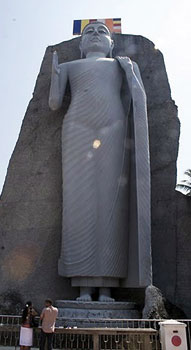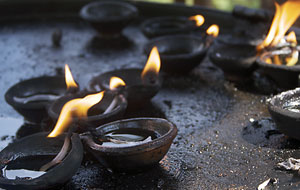We left the island’s south-south-west coast a little before one o’clock with our only goal to make it to any hotel in Tissamaharama (Tissa, for short) outside Yala National Park before five the next morning. It was the one real event we had planned (read: paid out the nose for, in advance) — a hired jeep to take us into Sri Lanka’s most famous nature reserve where elephants and monkeys and buffalo and leopards roamed free. We had only 200 kilometres to go and easy directions: keep ocean on right.
 |
Heading out of Midigama, we passed the fishermen perched in their traditional fish-hunting post, baking in the sun and waiting to spear fish in the water. And slowly but surely, traffic on the roads eased. After we passed the bold-on-the-map town of Matara, the pressure of the capital seemed to dwindle — our lightly battered Nissan cruised at fifty or sixty kph. The roads still had curves in places the land didn’t, but at least driving no longer felt like fighting off the evil Empire in the assault on the Death Star in the first Star Wars.
In a park near stands a massive stone Buddha. Cows graze nearby and visitors bring flowers to lay in offering. Camera in hand, it was more than impossible to blend in. Even in a sarong, even standing silently in meditation, our faces did not fall in the very narrow spectrum of local looks. I had no idea whether or not my picture-taking or my stupid, loud plaid shorts (I bought them in your country!) were offending anyone’s spiritual sensibilities. I didn’t know the customs — how could I? So, I tried to tell myself, anxiety doesn’t help anyone. And neither does worrying about when we’re going to get somewhere. The giant statue served as a reminder — don’t stress! With the smell of incense and birdsong in the air, the jingle of a passing ice cream truck made one thing very clear: anxiety is culturally insensitive.
The towns rolled by; we turned north off the coast at Hambantota, missed a few turns to Tissa, and finally cut east through park territory towards Kataragama. I stopped the car to take a picture of a silly sign that explained, at least in part, the essence of Sri Lankan driving — three separate speed limits, each sign marked with the silhouettes of a particular family of vehicles. On the other side of the road, piles of orange coconuts called out from a wooden hut, so we ran across to have a couple macheted open.
We met the family working in the roadside hut. The oldest man opened the coconuts with automatic dexterity, slicing open the top to unlock cups of the life-saving juice. Other men looked on: “What country?” A mother holding her baby daughter offered us a hard, super sweet candy to eat with the white coconut meat and watched intently as we tested the combo. They laughed no matter what faces we made — Americans, in sarongs, eating foods kids eat.
Between the two of us travellers, one was wearing a sarong and the other was wearing shorts and a sarong draped like a toga (it’s comfy for driving). I wondered what our hosts must have been thinking: Oy, Americans have no idea how to wear our clothes. Or maybe, told you, bro — Americans do so wear sarongs! How different do we assume each other to be?
I still get calls from the piles of orange coconuts on the side of the road, just now it shows up in my caller ID. They had encouraged us to take their pictures — we did and exchanged numbers, bemused but not yet tired of the habit. The connection continues.
We overshot Tissa until we hit the sea, where a brightly costumed group danced in celebration of the new moon on a rocky outcrop, and where waves crashed onto an old beach, grains of sand as big as cooked couscous. The sun set and we turned back once again towards the town outside the park.
Before we found the one hotel we knew enough to ask for, we passed the large domed temple at Tissa, like most, a huge white hemisphere crowned by a steeple.
The gates were open, and for a few cents we bought flower offerings to bring in and lay at the Buddha’s feet. It was, as is every full moon, a holiday. Families gathered and prayed meditating, seated; groups of men and groups of women circled the dome chanting, or silently; an old woman knelt palms pressed together by the statue of a bodhisattva. Gnats droned around the temple’s floodlights. The country was so beautiful in the moonlight — they asked us where we came from but there were no wrong answers — there weren’t even any “strange” answers. The old woman, now at the top of the stairs at the feet of a large seated Buddha, said words to me in Sinhalese.
“He’s Arab,” a younger man said to her (I could make out the word for “Arab”, though my Sinhalese knowledge is limited to the phrases for “where” and “how are you”, which I often confuse for each other.)
I didn’t say anything... what would I have said.
The writer has reported for Haaretz in Tel Aviv and is the founder of the online travelogue INGULFED.com. He lives and works in Abu Dhabi.
|




